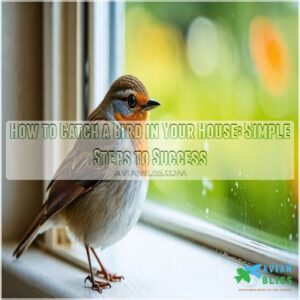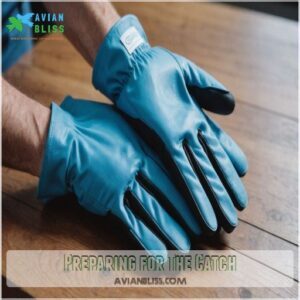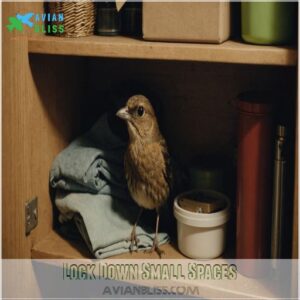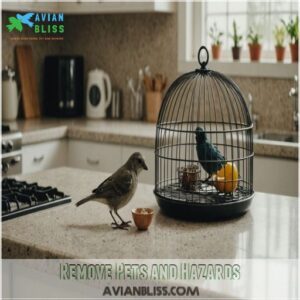This site is supported by our readers. We may earn a commission, at no cost to you, if you purchase through links.
 To catch a bird in your house, start by closing off any rooms to limit its flight path—just like a fun, impromptu escape room for birds!
To catch a bird in your house, start by closing off any rooms to limit its flight path—just like a fun, impromptu escape room for birds!
Switch off lights and draw curtains so the bird naturally heads for the brightest exit point.
Gently nab it with a soft towel or use a lightweight box for a stress-free capture.
Always handle it with kindness to avoid harm, and release it safely outdoors.
Think of yourself as a temporary zookeeper with a heart of gold.
For more bird-whispering wisdom, we’ve got a flock of tips lined up just for you.
Table Of Contents
- Key Takeaways
- Preparing for The Catch
- Containing The Bird
- Creating a Safe Exit Route
- Frequently Asked Questions (FAQs)
- What to do if a bird is trapped in your home?
- How to catch a bird in Your House?
- How do you catch a wild bird?
- How do you get a bird into a house?
- How do you get a wild bird out of Your House?
- What should you do if a bird comes into your house?
- How do you catch a bird in the house?
- How do you pick up a bird?
- How do you catch a bird trapped indoors?
- What to do if there’s a bird in your house?
- How do you lure a bird out of your house?
- What is the easiest way to catch a bird?
- How can I safely handle the bird?
- What should I do after catching the bird?
- How to keep my pets calm during capture?
- What if the bird is injured upon catching?
- Can I use food to lure the bird out?
- Conclusion
Key Takeaways
- Close off rooms to limit the bird’s flight path and create a single visible exit by opening windows or doors and turning off interior lights.
- Use a soft towel or lightweight net to gently capture the bird while wearing gloves to protect both you and the bird.
- Remove pets and hazards like ceiling fans, hot surfaces, and small gaps to ensure a safe environment, also be mindful of potential air hazards like aerosol poisoning risks, to guide the bird.
- Be patient and calm, using food as a lure if needed, and consult a wildlife expert if the bird appears injured.
Preparing for The Catch
Before you attempt to catch the bird, make sure you’re prepared with the right materials like gloves and a soft net, because a panicked bird and an unprepared person are a recipe for chaos.
Clear immediate dangers like ceiling fans and hot surfaces, and don’t forget to choose a large, unobstructed exit point to guide the bird safely out of your home.
Gather Necessary Materials
First, gather your supplies for this avian rescue mission!
You’ll need soft gloves for protection, a lightweight net for gentle capture, a soft towel for a comfy wrap, and a sturdy cardboard box.
Having a bird rehab number handy is also wise, just in case.
Remember, humane bird catching is key! This isn’t about trapping birds; it’s about safe bird removal.
These simple tools will help you release the trapped bird safely.
Eliminate Immediate Dangers
Now that you’ve gathered your materials, it’s time to bird-proof the space before your feathered friend causes chaos.
Turn off ceiling fans, cover those hot pots, and remove pets for their safety.
Open windows can be inviting, but block any small gaps with a small gap blocker to keep the bird on course.
Loose items should be tucked away—they’re not souvenirs!
Choose The Right Exit Point
Hope you’ve managed the dangers. Next, it’s time to choose the right exit point to free your feathered friend. Size matters here: match the bird size to window size for easy escape. Consider bird behavior—they’re drawn to light. Make sure the exit’s clear and wear soft gloves if you need to handle the bird.
- Room layout affects flight
- Exit visibility is
Containing The Bird
First, you’ll want to cleverly close off the area to keep the feathered guest from exploring the whole house, like it’s some kind of open house event.
Secure all those nooks and crannies—you know, the ones where socks go to disappear—and remove any pets or hazards to create a safe zone for all involved.
Close Off The Area
Birds can be flighty, but having contained the heart-pounding chaos with a plan can help.
Secure the perimeter by closing all doors to prevent escape.
Once you’ve corralled the feathered friend in one area, relief prevails.
This area lockdown minimizes the risk of more bird removal services swooping in.
You’ve cornered a trapped bird into a proper bird rescue.
Lock Down Small Spaces
After ensuring the room is sealed, it’s time to focus on locking down small spaces.
Check closets, cabinets, and even laundry baskets where the bird might hide.
Explore under furniture and peek behind appliances to prevent the bird from becoming trapped.
This bird removal process is all about keeping the bird safe while setting up for a smooth bird rescue.
Remove Pets and Hazards
As you lock down those sneaky hiding spots, don’t forget about pet safety and other hazards.
Secure pets in another room using a pet travel carrier, to prevent a chaotic tango of paws and feathers.
Turn off ceiling fans and cover any hot pots or pans to avoid unnecessary danger.
Pet safety and bird-proofing the kitchen are two easy steps toward a smooth bird removal.
Creating a Safe Exit Route
Now that your feathery friend is safely contained, let’s create a welcoming escape route.
Open the chosen window or door wide, close all others, and turn off the lights to gently guide your little visitor to freedom.
Open The Chosen Exit Window
Imagine you’re a trapped bird.
The best escape plan? An open window!
Choose a well-sized, unobstructed window as your target, and consider using a bird safe net to guide the bird out safely.
Open it slowly to avoid startling our feathery friend.
Consider bird behavior—the exit direction matters.
Make sure safety precautions are in place, turning this exit
Close All Other Windows
Windows are like neon signs for birds.
Close all but one window to focus their attention on the exit route.
This helps avoid bird behavior mishaps and makes sure bird safety.
Plus, it makes catching birds in the house a piece of cake!
Here are some bird removal tips:
- Use thick window coverings.
- Learn about different window types.
- Make sure clear light control.
Switch Off Interior Lights
Switching off interior lights gives the bird clarity in finding the way out.
Birds, with their night vision and instincts, are naturally drawn to light sources.
By dimming your home’s glow, you highlight the exit’s path, creating a safe escape route.
Don’t fret if it lingers; it just needs a moment to realize freedom’s within reach.
Frequently Asked Questions (FAQs)
What to do if a bird is trapped in your home?
Start by calmly closing off the area where the bird is.
Turn off lights, open a window or door for an escape route, and gently guide it outside with a sheet.
Avoid sudden movements to keep it stress-free.
How to catch a bird in Your House?
Don’t panic!
Gently guide it toward an open window or door, using a sheet if needed.
Keep calm, and it’ll likely fly out on its own.
If not, a soft towel might help.
Remember, safety first!
How do you catch a wild bird?
Catching a wild bird takes patience and care.
Use a humane trap with food as bait, like seeds or fruit.
Approach slowly and calmly.
Once caught, handle gently and consult a wildlife expert for proper care.
How do you get a bird into a house?
Sneaking a bird into your home might sound like a caper worthy of a cartoon.
However, make sure windows are open for easy access, tempt them with seeds, and provide a safe space for them to explore naturally.
How do you get a wild bird out of Your House?
Guide the bird out by closing other exits and opening one window or door.
Turn off any indoor lights to attract it to the bright exit.
Gently wave a sheet to guide it in the direction of freedom.
What should you do if a bird comes into your house?
Imagine a bird suddenly fluttering in – don’t panic!
Calmly close off the area, open a wide exit like a window or door, and softly guide it out with a sheet.
Birds prefer freedom to chaos!
How do you catch a bird in the house?
First, stay calm and make sure pets and fans are off.
Close other exits, leaving one open.
Use a towel or soft net to gently guide the bird out.
Speak softly to avoid spooking it further.
How do you pick up a bird?
Picking up a bird is like handling a fragile treasure.
Approach slowly, using a soft towel.
Gently wrap it without squeezing, ensuring it feels supported.
Keep calm; your steady hands and soft voice can comfort the little one.
How do you catch a bird trapped indoors?
Don’t panic!
Close windows, leaving one open.
Gently guide the bird in the direction of the exit using a sheet.
If it’s injured, contact a wildlife rehabilitator.
You’ve got this!
What to do if there’s a bird in your house?
Imagine a bird playing hide-and-seek in your home.
Calmly guide it outside by closing other exits, opening one wide pathway, and switching off lights.
Gently use a sheet to nudge the bird toward freedom.
How do you lure a bird out of your house?
Open a wide window or door for the bird’s escape.
Turn off lights, leading it in the direction of the natural light.
Use a gentle cloth "wall" to nudge it outside.
Stay calm; birds can sense stress!
What is the easiest way to catch a bird?
Calmly approach the bird holding a soft net or lightweight towel.
Move slowly to avoid scaring it.
Carefully drape the towel over the bird with gentle hands, lifting it gently, ensuring safety for both you and the bird.
How can I safely handle the bird?
Handling a bird safely is like gently cradling a delicate treasure.
Wear gloves to protect yourself and the bird.
Approach slowly, use a soft net or towel, and keep the bird calm as you guide it outside.
What should I do after catching the bird?
Gently release the bird outside, ensuring it’s safe and unharmed.
Check for any injuries; if you notice anything concerning, contact a wildlife rehabilitator.
Wash your hands thoroughly after handling the bird.
It’s all about careful kindness!
How to keep my pets calm during capture?
To keep your pets calm during a bird capture, move them to a separate room with soft music or their favorite toys.
A chew toy or treat can work wonders, distracting them from the excitement outside.
What if the bird is injured upon catching?
If you find the bird injured, carefully place it in a box lined with a soft towel. Then, contact a vet or wildlife rehabilitator immediately; they’re the experts!
Can I use food to lure the bird out?
Imagine this: You’re a crafty detective using birdseed as your secret weapon.
Food can indeed lure a bird toward freedom.
Place treats near the exit, but remain patient and watchful as the bird tiptoes out.
Conclusion
Congratulations on calmly coaxing the curious creature to freedom! Handling how to catch a bird in your house can be a breeze with patience and the right approach.
Remember, while the fluttering feathers might feel frantic, your composed guidance is key.
Savor the satisfaction of being a temporary zookeeper, where action meets empathy.
By preparing your space and creating clear exits, you guarantee a swift, stress-free release.
May your next unexpected visitor fly free, fast, and fearlessly!








